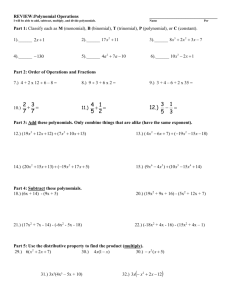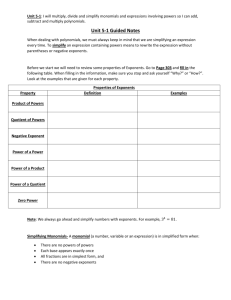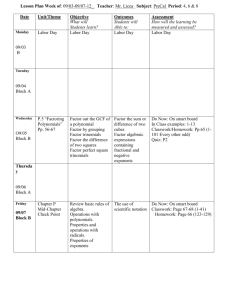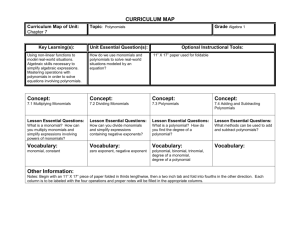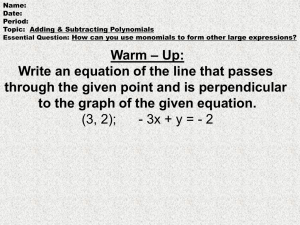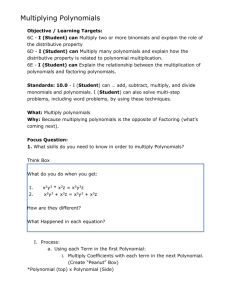2-Polynomial Operations-Unit Introduction
advertisement
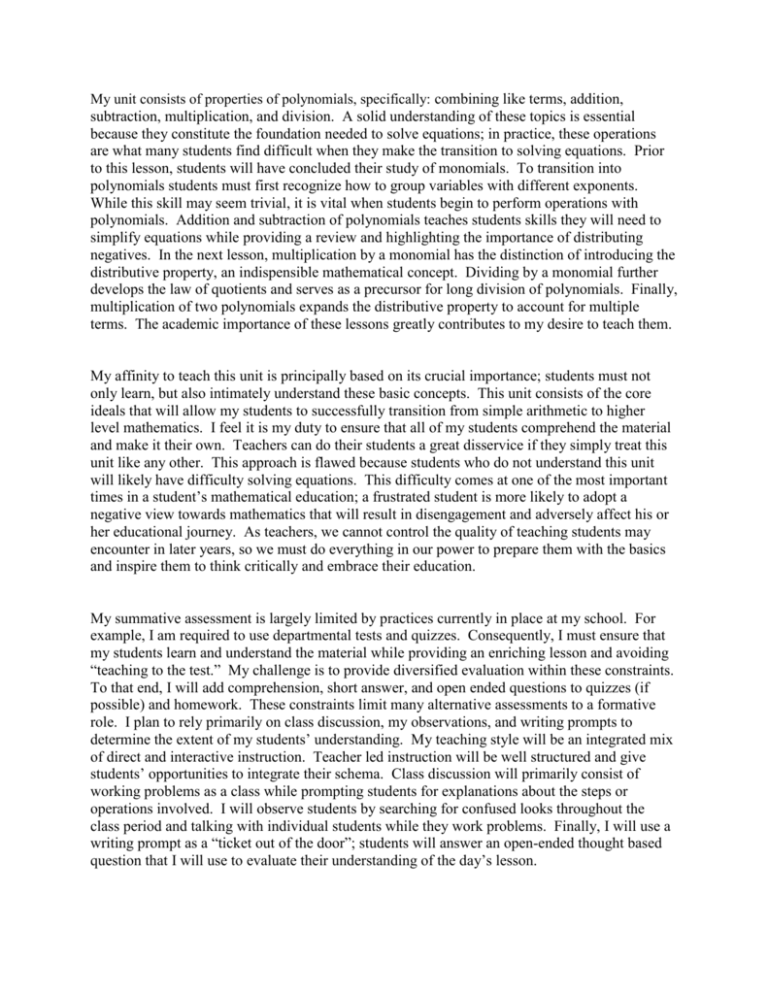
My unit consists of properties of polynomials, specifically: combining like terms, addition, subtraction, multiplication, and division. A solid understanding of these topics is essential because they constitute the foundation needed to solve equations; in practice, these operations are what many students find difficult when they make the transition to solving equations. Prior to this lesson, students will have concluded their study of monomials. To transition into polynomials students must first recognize how to group variables with different exponents. While this skill may seem trivial, it is vital when students begin to perform operations with polynomials. Addition and subtraction of polynomials teaches students skills they will need to simplify equations while providing a review and highlighting the importance of distributing negatives. In the next lesson, multiplication by a monomial has the distinction of introducing the distributive property, an indispensible mathematical concept. Dividing by a monomial further develops the law of quotients and serves as a precursor for long division of polynomials. Finally, multiplication of two polynomials expands the distributive property to account for multiple terms. The academic importance of these lessons greatly contributes to my desire to teach them. My affinity to teach this unit is principally based on its crucial importance; students must not only learn, but also intimately understand these basic concepts. This unit consists of the core ideals that will allow my students to successfully transition from simple arithmetic to higher level mathematics. I feel it is my duty to ensure that all of my students comprehend the material and make it their own. Teachers can do their students a great disservice if they simply treat this unit like any other. This approach is flawed because students who do not understand this unit will likely have difficulty solving equations. This difficulty comes at one of the most important times in a student’s mathematical education; a frustrated student is more likely to adopt a negative view towards mathematics that will result in disengagement and adversely affect his or her educational journey. As teachers, we cannot control the quality of teaching students may encounter in later years, so we must do everything in our power to prepare them with the basics and inspire them to think critically and embrace their education. My summative assessment is largely limited by practices currently in place at my school. For example, I am required to use departmental tests and quizzes. Consequently, I must ensure that my students learn and understand the material while providing an enriching lesson and avoiding “teaching to the test.” My challenge is to provide diversified evaluation within these constraints. To that end, I will add comprehension, short answer, and open ended questions to quizzes (if possible) and homework. These constraints limit many alternative assessments to a formative role. I plan to rely primarily on class discussion, my observations, and writing prompts to determine the extent of my students’ understanding. My teaching style will be an integrated mix of direct and interactive instruction. Teacher led instruction will be well structured and give students’ opportunities to integrate their schema. Class discussion will primarily consist of working problems as a class while prompting students for explanations about the steps or operations involved. I will observe students by searching for confused looks throughout the class period and talking with individual students while they work problems. Finally, I will use a writing prompt as a “ticket out of the door”; students will answer an open-ended thought based question that I will use to evaluate their understanding of the day’s lesson. South Carolina State Standards Standard EA-2: The student will demonstrate through the mathematical processes an understanding of the real number system and operations involving exponents, matrices, and algebraic expressions. EA-2.2 Apply the laws of exponents and roots to solve problems. EA-2.5 Carry out a procedure using the properties of real numbers (including commutative, associative, and distributive) to simplify expressions. EA-2.7 Carry out a procedure (including addition, subtraction, multiplication, and division by a monomial) to simplify polynomial expressions. National Standards Algebra: Understand patterns, relations, and functions (grades 9-12) Use symbolic algebra to represent and explain mathematical relationships Understand the meaning of equivalent forms of expressions, equations, inequalities, and relations Communication: Organize and consolidate their mathematical thinking through communication Communicate their mathematical thinking coherently and clearly to peers, teachers, and others Unit Objectives Combining Like Terms: Students will be able to communicate verbally and in writing the definition of like terms Students will be able to identify like terms in polynomial expressions Students will be able to mathematically combine like terms in polynomial expressions Students will be able to generate examples and non-examples of like terms Students will be able to apply knowledge of like terms to practical situations Adding and Subtracting Polynomials Students will be able to identify an expression as a monomial, binomial, or trinomial Students will be able to explain the difference between a monomial, binomial, and trinomial Students will be able to add polynomials Students will be able to subtract polynomials Multiplying Polynomials by Monomials Students will be able to multiply a monomial with a positive coefficient by a polynomial Students will be able to multiply a monomial with a negative coefficient by a polynomial Students will be able to apply the distributive property and the product of powers property to simplify expressions Multiplying Polynomials Students will be able to multiply polynomials by adding areas of a rectangle Students will be able to multiply polynomials with one variable using the process of distribution Students will be able to multiply polynomial with multiple variables using the process of distribution Dividing Polynomials by Monomials Students will be able to divide polynomials by monomials of one variable using the laws of exponents Students will be able to divide polynomials by monomials with multiple variables using the laws of exponents

